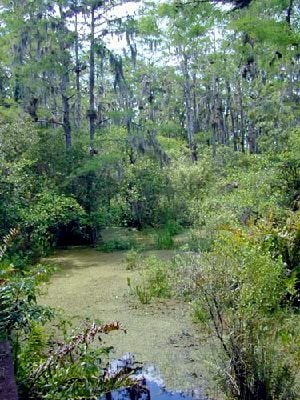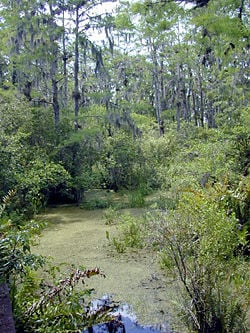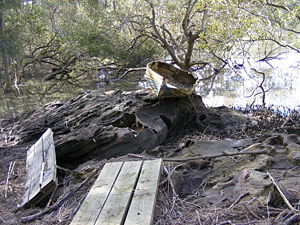Difference between revisions of "Swamp" - New World Encyclopedia
Rick Swarts (talk | contribs) (added most recent Wikipedia version) |
Rick Swarts (talk | contribs) (added content from NWE wetland article) |
||
| Line 7: | Line 7: | ||
In North America, swamps are usually regarded as including a large amount of woody [[vegetation]], but elsewhere this may not necessarily apply, such as in African swamps dominated by [[papyrus]]. By contrast a [[marsh]] in North America is a wetland without woody vegetation, or elsewhere, a wetland without woody vegetation which is shallower and has less open water surface than a swamp. A '''mire''' (or '''quagmire''') is a low-lying wetland of deep, soft soil or mud that sinks underfoot. | In North America, swamps are usually regarded as including a large amount of woody [[vegetation]], but elsewhere this may not necessarily apply, such as in African swamps dominated by [[papyrus]]. By contrast a [[marsh]] in North America is a wetland without woody vegetation, or elsewhere, a wetland without woody vegetation which is shallower and has less open water surface than a swamp. A '''mire''' (or '''quagmire''') is a low-lying wetland of deep, soft soil or mud that sinks underfoot. | ||
| + | |||
| + | note:Wetlands provide innumerable [[economy|economic]], [[ecology|ecological]], [[culture|cultural]], [[recreation|recreational]], and aesthetic values. The rich [[biodiversity]] of wetlands has led to their being described as "biological supermarkets" and "nurseries of life"; their chemical and hydrological functions have led to their characterization as "the kidneys of the landscape" (Barbier et al. 1997; Mitsch and Gosselink 1993). They offer goods such as [[fish]], timber, and peat; supply water; provide flood control; are important for groundwater recharge and discharge, water purfication, and nutrient retention; are habitat to a great amount of flora and fauna; and add to the human wonder of nature. | ||
| + | |||
| + | Note:[[Marsh]]es are dominated by soft-stemmed vegetation, while [[swamp]]s in the [[United States]] are dominated by woody plants (EPA 2004). White cedar, tamarack, and white pine are examples of trees found in swamps in the United States. | ||
| + | |||
| + | note: A [[swamp]] is wetland with more open water surface and deeper water than a marsh. In North America, it is used for wetlands dominated by trees and woody bushes rather than grasses and low herbs, but this distinction does not necessarily apply in other areas, for instance in [[Africa]] where swamps may be dominated by papyrus. | ||
| + | |||
| + | note:* A [[Mangrove|mangrove swamp]] or mangal is a salt or brackish water environment dominated by the [[Mangrove#Species|mangrove species of tree]], such as ''Sonneratia''. | ||
| + | |||
| + | In the [[United States]], the four general categories of wetlands, according to the Environmental Protection Agency, are marshes, swamps, bogs, and fens. The [[U.S. Fish and Wildlife Service]]'s [[National Wetlands Inventory]] (NWI) produces and provides information on the characteristics, extent, and status of U.S. wetlands and deepwater habitats and other wildlife habitats. The NWI also produces periodic reports on the status and trends of wetlands in the conterminous U.S. The NWI website includes a [http://wetlandsfws.er.usgs.gov/NWI/index.html Wetlands Mapper] in which users can view, download, or print maps of digital wetlands information. | ||
| + | |||
| + | |||
==Geology== | ==Geology== | ||
[[Image:2007 0817klklk0054.JPG|thumb|right|300px|A small swamp in the [[Hawkesbury River]], [[New South Wales]].]] | [[Image:2007 0817klklk0054.JPG|thumb|right|300px|A small swamp in the [[Hawkesbury River]], [[New South Wales]].]] | ||
| + | |||
| + | A '''wetland''' is a transitional environment between permanently aquatic and terrestrial environments that shares characteristics of both environments and where [[water]], which covers the [[soil]] or is near the surface for substantial parts of the year, is the key factor in determining the nature of the [[ecosystem]] and soil. Although wetlands have aspects similar to both wet and and dry environments, they cannot be classified unambiguously as either aquatic or terrestrial (Barbier et al. 1997). Wetland do not have to be wet all the time, but generally are at least periodically covered by or saturated with water. Among types of wetlands are [[swamp]]s, [[marsh]]es, and bogs (defined below). | ||
| + | |||
| + | |||
Swamps are generally characterised by very slow-moving waters. They are usually associated with adjacent [[river]]s or [[lake]]s. In some cases, rivers become swamps for a distance. Swamps are features of areas with very low [[topographic]] relief, although they may be surrounded by mountains. | Swamps are generally characterised by very slow-moving waters. They are usually associated with adjacent [[river]]s or [[lake]]s. In some cases, rivers become swamps for a distance. Swamps are features of areas with very low [[topographic]] relief, although they may be surrounded by mountains. | ||
| Line 87: | Line 103: | ||
<references/> | <references/> | ||
<br> | <br> | ||
| + | |||
| + | * Environmental Protection Agency. 2006a. [http://www.epa.gov/owow/wetlands/vital/what.html What are wetlands?]. ''U.S. Environmental Protection Agency''. Retrieved July 24, 2007. | ||
| + | * Environmental Protection Agency. 2006b. [http://www.epa.gov/owow/wetlands/what/definition.html Wetlands definitions]. ''U.S. Environmental Protection Agency''. Retrieved July 24, 2007. | ||
| + | * Environmental Protection Agency. 2004. Wetlands overview. ''U.S. Environmental Protection Agency'' EPA 843-F-04-011a (December 2004). Retrieved July 24, 2007. | ||
[[Category:Life sciences]] | [[Category:Life sciences]] | ||
{{credit|Swamp&oldid=171316706}} | {{credit|Swamp&oldid=171316706}} | ||
Revision as of 18:06, 15 November 2007

A swamp is a wetland that features temporary or permanent inundation of large areas of land by shallow bodies of water, generally with a substantial number of hammocks, or dry-land protrusions, and covered by aquatic vegetation, or vegetation that tolerates periodical inundation.[1] The water of a swamp may be fresh water or salt water. A swamp is also generally defined as having no substantial peat deposits.[2]
In North America, swamps are usually regarded as including a large amount of woody vegetation, but elsewhere this may not necessarily apply, such as in African swamps dominated by papyrus. By contrast a marsh in North America is a wetland without woody vegetation, or elsewhere, a wetland without woody vegetation which is shallower and has less open water surface than a swamp. A mire (or quagmire) is a low-lying wetland of deep, soft soil or mud that sinks underfoot.
note:Wetlands provide innumerable economic, ecological, cultural, recreational, and aesthetic values. The rich biodiversity of wetlands has led to their being described as "biological supermarkets" and "nurseries of life"; their chemical and hydrological functions have led to their characterization as "the kidneys of the landscape" (Barbier et al. 1997; Mitsch and Gosselink 1993). They offer goods such as fish, timber, and peat; supply water; provide flood control; are important for groundwater recharge and discharge, water purfication, and nutrient retention; are habitat to a great amount of flora and fauna; and add to the human wonder of nature.
Note:Marshes are dominated by soft-stemmed vegetation, while swamps in the United States are dominated by woody plants (EPA 2004). White cedar, tamarack, and white pine are examples of trees found in swamps in the United States.
note: A swamp is wetland with more open water surface and deeper water than a marsh. In North America, it is used for wetlands dominated by trees and woody bushes rather than grasses and low herbs, but this distinction does not necessarily apply in other areas, for instance in Africa where swamps may be dominated by papyrus.
note:* A mangrove swamp or mangal is a salt or brackish water environment dominated by the mangrove species of tree, such as Sonneratia.
In the United States, the four general categories of wetlands, according to the Environmental Protection Agency, are marshes, swamps, bogs, and fens. The U.S. Fish and Wildlife Service's National Wetlands Inventory (NWI) produces and provides information on the characteristics, extent, and status of U.S. wetlands and deepwater habitats and other wildlife habitats. The NWI also produces periodic reports on the status and trends of wetlands in the conterminous U.S. The NWI website includes a Wetlands Mapper in which users can view, download, or print maps of digital wetlands information.
Geology
A wetland is a transitional environment between permanently aquatic and terrestrial environments that shares characteristics of both environments and where water, which covers the soil or is near the surface for substantial parts of the year, is the key factor in determining the nature of the ecosystem and soil. Although wetlands have aspects similar to both wet and and dry environments, they cannot be classified unambiguously as either aquatic or terrestrial (Barbier et al. 1997). Wetland do not have to be wet all the time, but generally are at least periodically covered by or saturated with water. Among types of wetlands are swamps, marshes, and bogs (defined below).
Swamps are generally characterised by very slow-moving waters. They are usually associated with adjacent rivers or lakes. In some cases, rivers become swamps for a distance. Swamps are features of areas with very low topographic relief, although they may be surrounded by mountains.
Ecology
Swamps are characterised by rich biodiversity and specialised organisms such as frogs.[3] For instance, southeastern U.S. swamps, such as those mentioned above, feature trees such as the Bald cypress and Water tupelo, which are adapted to growing in standing water, and animals such as the American alligator. A common species name in biological nomenclature is the Latin palustris, meaning "of the swamp". Examples of this are Quercus palustris (pin oak) and Thelypteris palustris (marsh fern).
Draining
Swamps were historically often drained to provide additional land for agriculture, and to reduce the threat of diseases born by swamp insects and similar animals. Swamps were generally seen as useless and even dangerous. This practice of swamp draining is nowadays seen as a destruction of a very valuable ecological habitat type of which large tracts have already disappeared in many countries.
Famous examples
In Iraq
The Tigris-Euphrates river system is a large swamp and river system in southern Iraq, inhabited in part by the Marsh Arabs. It was partly drained by Saddam Hussein in the 1990s in retaliation against the Shiite tribes' revolt against his dictatorship.

In the United States
The most famous swamps in the United States are the Everglades, Okefenokee Swamp and the Great Dismal Swamp. The Okefenokee is located in extreme southeastern Georgia and extends slightly into northeastern Florida. The Great Dismal Swamp lies in extreme southeastern Virginia and extreme northeastern North Carolina. Both are National Wildlife Refuges. Another swamp area, Reelfoot Lake of extreme western Tennessee, was created by the New Madrid earthquake of 1812. Caddo Lake, the Great Dismal and Reelfoot are swamps that are centered at large lakes. Swamps are often called bayous in the southeastern United States, especially in the Gulf Coast region.
Heraldry
A swamp appears in the coat of arms of Gesturi, Italy.
List of major swamps
Africa
Asia
North America
- Great Black Swamp, United States
- Great Dismal Swamp, United States
- Great Pocomoke Swamp also known as Great Cypress Swamp, Maryland, United States
- Okefenokee Swamp, Georgia/Florida, United States
- Reelfoot Lake, United States
- Big Cypress National Preserve, Florida, United States
- Limberlost, Indiana, United States
- Honey Island Swamp, Louisiana, United States
- Great Swamp National Wildlife Refuge, New Jersey, United States
- Atchafalaya National Wildlife Refuge, Louisiana, United States
South America
See also
|
|
|
ReferencesISBN links support NWE through referral fees
- Environmental Protection Agency. 2006a. What are wetlands?. U.S. Environmental Protection Agency. Retrieved July 24, 2007.
- Environmental Protection Agency. 2006b. Wetlands definitions. U.S. Environmental Protection Agency. Retrieved July 24, 2007.
- Environmental Protection Agency. 2004. Wetlands overview. U.S. Environmental Protection Agency EPA 843-F-04-011a (December 2004). Retrieved July 24, 2007.
Credits
New World Encyclopedia writers and editors rewrote and completed the Wikipedia article in accordance with New World Encyclopedia standards. This article abides by terms of the Creative Commons CC-by-sa 3.0 License (CC-by-sa), which may be used and disseminated with proper attribution. Credit is due under the terms of this license that can reference both the New World Encyclopedia contributors and the selfless volunteer contributors of the Wikimedia Foundation. To cite this article click here for a list of acceptable citing formats.The history of earlier contributions by wikipedians is accessible to researchers here:
The history of this article since it was imported to New World Encyclopedia:
Note: Some restrictions may apply to use of individual images which are separately licensed.


